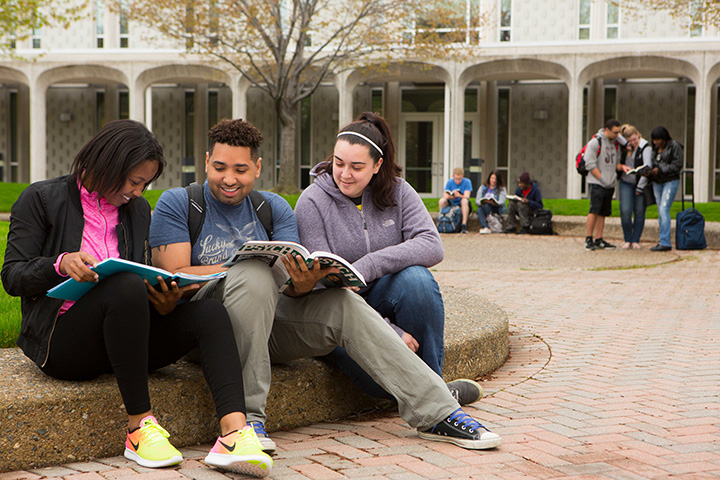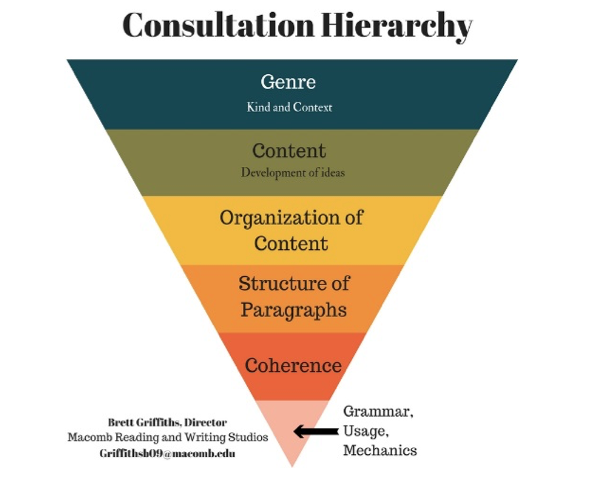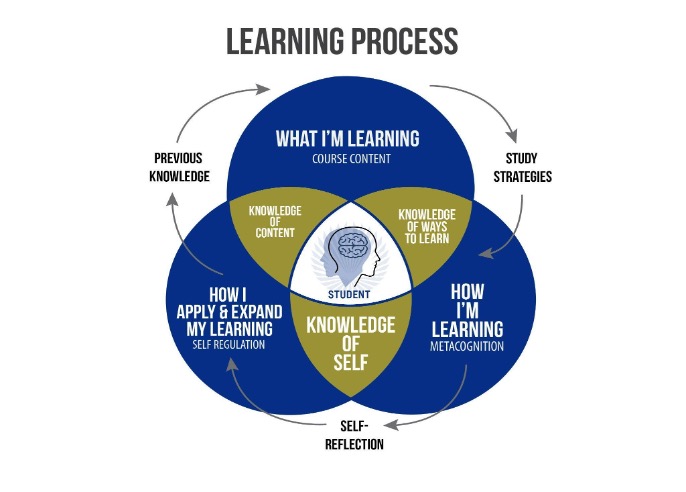
October 14, 2022 | Brett Griffiths and Kathryn Lutes
In 2020, Macomb Community College combined the college’s academic literacy and writing center and academic content tutoring center under one administrative team, allowing the college to reimagine tutoring services to better meet the needs of our students enrolled in remote, online, hybrid, and in-person courses. This shift—combined with the educational impacts we observed from COVID-19—encouraged us to apply what we had learned in working with students on reading and writing to other disciplines such as math, business, and physics and to develop new ways to support self-regulated learning across disciplines.
The time was ripe for this work. Recent scholarship has highlighted the disconnect between disciplinary pedagogies and research in higher education over the last 5 decades, including ways to more equitably support students’ learning and improve completion rates at open-access institutions. Identifying and reinforcing these connections helps underscore the importance of discipline-specific pedagogies in community college reforms, as well as the crucial role students play in their own learning.
This development, along with renewed interest in Barry Zimmerman’s conceptualization of self-regulated learning and its role in student success, provides a rich opportunity to share our writing center’s models for incorporating self-regulated learning into our tutoring practices, ones that other educational professionals can apply across the disciplines at their institutions.
Building on Existing Models
We developed our original learning models in the Macomb Reading and Writing Studios before they merged with the Learning Centers, the college’s tutoring centers. Three intersecting philosophies informed the models:
- Writing center scholarship that emphasizes process. When students better understand their own composing and revising practices, they can better adapt to new writing situations.
- The notion that writing is socially contextualized. Readers expect different kinds of writing from different kinds of texts, and writers need to learn to adapt their writing to perform for those differences. This understanding led writing instructional experts to make identifying and predicting the needs of distinct genres a cornerstone of writing instruction. This approach better prepares students to apply what they learn about writing in new situations, including future courses, disciplines, and professions (called writing transfer).
- The self-regulation process for writing is important. By embedding self-regulated learning strategies into writing instruction, learners may gain more agency by engaging, reflecting, and choosing the strategies they take up and apply.
We created the Consultation Hierarchy infographic, which has been adopted by several other writing centers, to emphasize the importance of attending explicitly to genre and content before attending to lower-order issues, such as grammar and mechanics, precisely because the practice and role of writing support are so often misunderstood as a “grammar issue,” even while decades of research have debunked this myth, leading to the fraught implementation of student success initiatives.

We put the philosophy into practice by creating a consultation protocol and session summary forms, which scaffold self-regulation for both the learner and the writing studio consultant.1 The procedure has three main components:
- Agenda Setting: Learners and consultants set the session agenda collaboratively, prioritizing 1–3 goals for a 30–60-minute session.
- Engagement: Consultants use Socratic inquiry to engage learners in close and critical reading and reflection about their own writing, moving from higher-order concerns (e.g., genre, content) to lower-order concerns (e.g., grammar).
- Self-Reflection: In the last 10 minutes of the session, consultants help students to reflect and record what they have learned and plan their next steps for the assignment using a session summary report form.
This procedure established a predictable, yet flexible structure tutors and students could apply to each piece of writing. By embedding Zimmerman and Campillo’s (2003) self-regulation cycle, consultants functionally modeled the process for learners to practice independently. Institutional assessment during our first year found this consultation procedure was effective: Students who attended two or more Studios sessions had an average increase in GPA of 0.66 per semester, after controlling for demographic variables and available proxies for noncognitive factors, such as motivation.
Evolving a Flexible Model for Self-Regulated Tutoring
In 2020–21, as our institution responded to COVID-19, the Reading and Writing Studios merged with the Learning Centers, which do academic content tutoring, under the same administrative team. Besides their focus on subject tutoring, the Learning Centers differed from the Studios in their protocols. The Learning Center tutors conducted studio-style drop-in group tutoring, rather than sustained, hour-long collaborative sessions. This presented an opportunity to revise and expand the ways we conceptualized tutoring for our learners and staff, embedding a more robust and flexible model of self-regulation without sacrificing the core elements of learning.
We began by soliciting observations from the Learning Center tutors about their experiences and conducting our own observations. We observed that our tutors—both professional and peer tutors—felt pressured to provide short-term tutoring solutions, including “shortcuts” (e.g., doing problems for the students), so that students achieved the “right answers,” in part due to their perception that having the correct answer was prioritized over understanding the material. However, tutors were not rewarded for working on long-term outcomes, such as gradual gains in conceptual knowledge and knowledge transfer. The “right answer” approaches unintentionally encouraged students to become more dependent on tutors instead of more independent.
Our conversations with tutors helped us to devise the graphic model, below, which centers the student and highlights the role of the student’s previous knowledge and the importance of reflection.

Macomb Learning Centers Model for Self-Regulated Learning Process
This model offers several advantages for conceptualizing the work of tutors via its flexible, cyclical design, which can be adapted to multiple learning situations.
- Previous Knowledge: This model prioritizes students’ prior learning (about content, self, or education). We ask students to tell us what they already know first, thus helping to avoid ineffective strategies and positioning students as responsible and agentive learners.
- Study Strategies (Engagement): Here, participants focus on the learning objectives and content. However, the intersecting elements of this model prompt participants to consider how they each learn differently and connect their specific learning approach with their previous knowledge. This introduces metacognition (goal-setting, identifying learning, and reflecting on learning) and reinforces personal connection throughout the learning process.
- Self-Reflection: We formalized this process by requiring tutors and students to complete the session summary form collaboratively. Learners describe what clicked (or did not) in each session and articulate their next steps, using a set of preformatted steps for self-regulated learning. Submission of the form auto-generates an email copy for both learner and tutor.
This approach expands the self-regulation model by considering the learning process as shared, collaborative, cyclical, and ongoing. It also offered tutors opportunities to deliberatively reflect on the sessions and the take-aways learners identified. While initially a challenge, the process of formalizing reflection and documentation of each session ultimately helped tutors see this process as part of the learning of the session rather than cumbersome—and useless—paperwork after the fact, leaving both tutors and learners with a record of their conversations and practical tools to use in the future.
Transfer and Beyond: Adapting and Implementing Self-Regulated Learning at Your Institutions
Our department benefited from the deliberations that contributed to our revised self-regulation model as much as we benefit from the models themselves. These models make more concrete and replicable self-regulated learning processes for both learners and educators. They are flexible enough to accommodate multiple kinds of learning situations—from welding to physics. As such, we hope that teachers, learners, and administrators will use this model to generate deep, deliberate conversations about how to define learning at the classroom and institutional levels, foster increased learner agency within the learning process, especially for developing learners, name and validate the knowledge and experiences learners bring to their formal education, and embed intentional practices to help students transfer their learning from the artificial environment of the classroom or tutoring center to the future, where their learning will matter most.
Footnotes
Brett Griffiths teaches reading and writing at Schoolcraft College and is the former and founding director of the Reading and Writing Studios at Macomb Community College. She is the editorial co-author of the collection currently titled Two-Year College Writing Studies: Rationales and Praxis for Just Teaching, forthcoming from Utah State University Press in 2023. Kate Lutes is the coordinator for special projects and outreach for the Learning Centers and Reading and Writing Studios at Macomb Community College. Leah Bublitz, the former manager for Macomb’s Reading and Writing Studios and Learning Centers, contributed to the ideas in this blog post.
Tags: Self-directed Learning